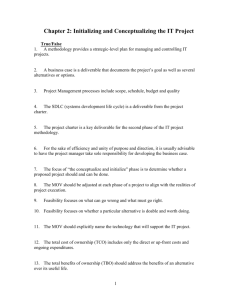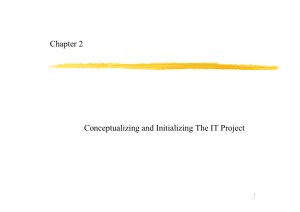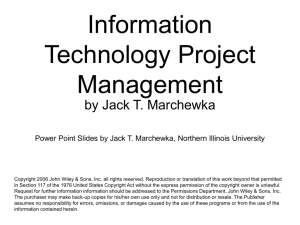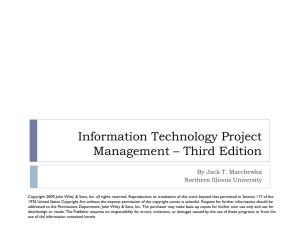Software Project Management
advertisement
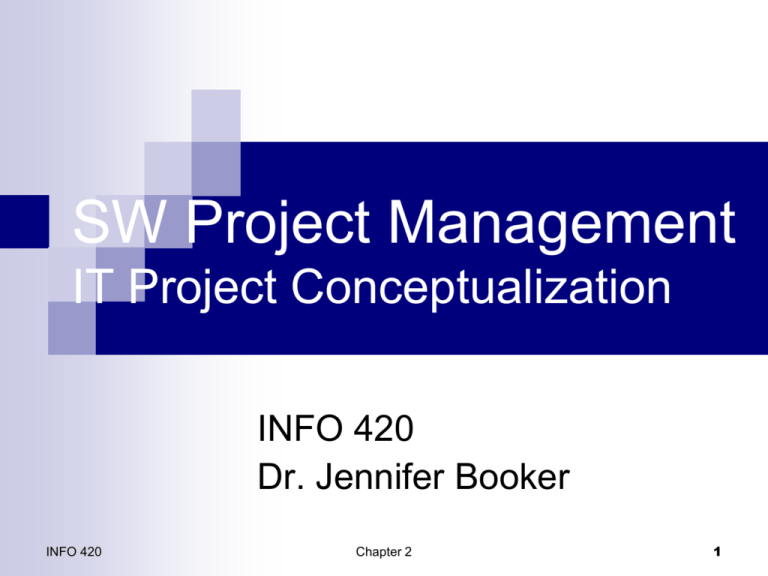
SW Project Management
IT Project Conceptualization
INFO 420
Dr. Jennifer Booker
INFO 420
Chapter 2
1
Project conceptualizing and
initiation
Now we’ll expand on the project life cycle,
and examine its first phase in detail
The ‘IT project methodology’ used
throughout the text is fairly typical as a
foundation, but every project tailors its
base methodology to meet its own needs
INFO 420
Chapter 2
2
Project conceptualizing and
initiation
This chapter focuses on defining the goal
for a project, and several objectives to
help meet that goal
Then we’ll expand on the business case
concept, including MOV and feasibility
The higher level governing structure to
choose IT projects will be discussed
INFO 420
Chapter 2
3
IT Project Methodology (ITPM)
A project methodology provides the overall
strategy for managing and controlling them
This
describes the overall game plan
The methodology recommends phases,
deliverables, processes, tools to support
projects; but your project’s needs may differ!
Sharing a common foundation also makes
CMMI level 3+ happy
INFO 420
Chapter 2
4
ITPM
Using a common methodology also helps
managers decide which projects should be
supported, and makes cross-project
measurements feasible
The
ITPM is flexible to accommodate any
SDLC, and may be further adjusted for the
skill level of the project team, project size,
application type, etc.
INFO 420
Chapter 2
5
ITPM phases and deliverables
1.
2.
3.
4.
5.
Conceptualize and initialize project – delivers
the business case
Develop project plan and charter – delivers
them
Execute & control project – follows an SDLC,
and delivers the completed system
Close project – delivers a final project report
and presentation
Evaluate project – delivers a project evaluation
and lessons learned
INFO 420
Chapter 2
6
Phase 1
Conceptualize and initialize project defines
the goal of the project, and how it will add
value to the organization
Do
so by comparing project to possible
alternatives, and making a cost/benefit,
feasibility, and risk analysis to prove which
choice is best
This produces the project’s business case
INFO 420
Chapter 2
7
Phase 2
Develop project plan and charter
The
project charter defines the project
organization, and how the project will be
implemented
It clarifies the project goal in terms of scope,
schedule, budget, and quality standards
The project plan answers the who/what/
where/when/why/how questions
INFO 420
Chapter 2
8
Phase 2
The business case (phase 1) and project
plan (phase 2) are kept separate
The
business case focuses on how well the
project matches the business strategy
Should the project be done at all?
The
project plan focuses on how the project
will be achieved – more tactical concerns
INFO 420
How will we make the project happen?
Chapter 2
9
Phase 3
Execute & control project carries out the
project plan
Project manager must make sure the
resources and infrastructure are available
to the project team
People,
technical infrastructure
Development methods and tools
INFO 420
Chapter 2
10
Phase 3
Also need to provide:
Work
environment
Controls over scope,
schedule, budget, and
quality
Human resources
system
INFO 420
Chapter 2
And use plans for:
Risk
management
Procurement
Quality management
Change management
Communications
Testing
Implementation
11
Phase 4
Close project transfers control from the
development team to the client or sponsor
Team
should make a final project report and
presentation to document everything was
accomplished
Allows final project cost and schedule to be
measured
Archive project files, release resources
INFO 420
Chapter 2
12
Phase 5
Evaluate project success, often called a
‘post-mortem’ review
Project
manager and team review what
worked, what didn’t
Record lessons learned, look for broader
best practices
Can review individual performance
INFO 420
Chapter 2
13
Phase 5 - Third party review
Can get third party review of the project
Will
project meet its goal?
How about scope, schedule, budget, and
quality objectives?
Did we deliver everything promised?
Is the client happy?
INFO 420
Chapter 2
14
Phase 5 - Third party review
Did
we follow our own processes and
methodology?
How did we handle risks and problems?
How well did we work with the sponsor?
Did we behave ethically and professionally?
Did the project provide value to the
organization? (if you can tell yet)
INFO 420
Chapter 2
15
ITPM Foundation
The ITPM is based on having five sets of
resources available to the team
PM
process groups
Objectives for this project
Tools
Infrastructure
And the PMBOK knowledge areas
INFO 420
Chapter 2
16
PM process groups
These groups of processes are the
activities needed to carry out the project
life cycle
Initiating
processes
Planning processes
Executing processes
Controlling processes
Closing processes
INFO 420
Chapter 2
17
Objectives for this project
The objectives for this project, taken
together, ensure the project goal is met
The objectives typically address four areas
Scope
Schedule
Budget
Quality
INFO 420
Chapter 2
18
Tools
Tools support the project processes, and
creation of the product itself
Could
include estimation tools, requirements
management tools, cost/schedule tools,
quality tools, etc.
The development environment (IDE, CASE
tools) are in this category too
(Yes,some consider this part of infrastructure)
INFO 420
Chapter 2
19
Infrastructure
This includes three categories of
infrastructure
– define project organization,
roles, reporting structure
Project – the physical environment,
processes, and controls
Technical – general tools: email, Office suite,
Internet access, PM software, etc.
Organizational
INFO 420
Chapter 2
20
PMBOK knowledge areas
The lessons learned from past projects
feeds into the PMBOK knowledge areas,
This can refine your project methodology
to suit your needs, culture, and
environment
INFO 420
Chapter 2
21
Business case
Now we’ll look in detail at how to develop a
business case for a project
What reasons might be used to justify an IT
project?
Reduce cost, create new product, improve customer
service, processes, reporting, communication,
decision making, create stronger connection to
suppliers or customers, meet legal requirements
INFO 420
Chapter 2
22
Business case process
Assess
TCO
Assess TBO
Analyze alternatives
Propose & support
recommendation
The process for
preparing a business
case has about eight
steps
Select
core team
Define MOV
Identify alternatives
Assess feasibility
INFO 420
Chapter 2
23
Select core team
The team to develop the business case
should come from multiple perspectives –
business, technical, management, etc.
Provides
a better balanced viewpoint
Enhances credibility, gets buy-in across org.
Better alignment with organizational goals
Better access to detailed supporting data
INFO 420
Chapter 2
24
Define MOV
MOV is Measurable Organizational Value
The MOV must be some characteristics
that can be objectively measured, to prove
the project provided real value to the org
MOV
proves success or failure of the project
All key stakeholders must agree on MOV
MOV must also support the org’s strategy
INFO 420
Chapter 2
25
Define MOV
There are six steps to defining MOV
(Yes, all within step 2 of writing a business case)
Identify desired area of impact
Identify desired value of the project
Develop an appropriate metric
Set a time frame for achieving MOV
Get agreement from stakeholders
Summarize MOV in a statement
INFO 420
Chapter 2
26
Identify desired area of impact
Where will this project affect the
organization? (could be more than one)
Strategic:
new markets, products & services
Customer: better products & services, better
loyalty, higher satisfaction
Financial: increased profits, profit margins
Operational: lower costs, higher efficiency
Social: education, health, safety, environment
INFO 420
Chapter 2
27
Identify desired value of the project
Ok, now within each area of impact, what
will the project do to provide value?
Will it help you do something:
Better?
(e.g. quality, effectiveness)
Faster? (speed, efficiency, cycle time)
Cheaper? (reduce cost!)
Or do more in some way? (new markets,
products)
INFO 420
Chapter 2
28
Develop an appropriate metric
So how will you measure that value?
$$
- generate $x in new sales
Percentage - reaching at least a certain
number (customer satisfaction > 95%)
Numbers – have at least y new customers
Don’t get fancy – simple, clear measures
are often the best
INFO 420
Chapter 2
29
Develop an appropriate metric
Make it clear how the measure will be
collected
Might
need surveys, competitor data, etc.
Make sure the measure really addresses
the value you wish to measure
Some
things like loyalty or satisfaction are
hard to nail down
INFO 420
Chapter 2
30
Set a time frame for achieving MOV
Determine how long it’ll take to achieve
the MOV
have multiple time objectives – reach x
by 6 months, y by 12 months, etc.
Could
INFO 420
Chapter 2
31
Get agreement from stakeholders
Yup, easy to say, much harder to achieve
Everyone (project manager, sponsor, etc.)
needs to agree the MOV is realistic
Don
Quixote may like impossible dreams, but
most techies hate impossible goals
INFO 420
Chapter 2
32
Summarize MOV in a statement
So what’s the output from all this work?
A sentence or two, or maybe a short table,
to summarize the MOV (or MOVs if there
are multiple) and it/their time frames
“Project
XYZ will achieve {the MOV} within
{the time frame} after its completion”
Or something vaguely like that…
INFO 420
Chapter 2
33
Identify alternatives
Now back to the overall business case,
step 3 - Identify alternatives
Most problems can be solved more than
one way, so your job is to brainstorm and
find several* plausible ways to address
the problem
One
can be the ‘change-nothing’ answer
* (for homework, at least three)
INFO 420
Chapter 2
34
Identify alternatives
Alternatives can examine many possible
approaches, such as
Change
processes but keep the existing
systems
Reengineer an existing system
Buy something off the shelf to replace an
existing system
Start over, and make a new system
INFO 420
Chapter 2
35
Assess feasibility
Step 4 is to assess the feasibility and risks
of each alternative
Feasibility assessment consists of
considering three dimensions
feasibility – a full cost/benefit
analysis is nice, but at least determine if the
cost of each alternative is within reach
Economic
INFO 420
Chapter 2
36
Assess feasibility
Technical
feasibility measures whether the
alternative can be accomplished
Do you have the infrastructure, skills, equipment,
experience, etc. to implement each alternative?
If not, can the deficiencies be met reasonably?
Would you need to consider outsourcing or other
outside sources?
INFO 420
Chapter 2
37
Assess feasibility
Organizational
feasibility considers each
alternative’s impact on your organization
Would it result in major changes?
Will jobs be affected?
Will people welcome a new approach?
Other
possible areas of feasibility could
include legal or ethical concerns
INFO 420
Are there, e.g. union conflicts or labor law
concerns?
Chapter 2
38
Assess feasibility
The risk assessment should identify major
plausible risks to the success of the
project
Not
the success of the product produced
What could keep the project from reaching
its conclusion on time and within budget?
INFO 420
Chapter 2
39
Assess feasibility
Identify each risk
Estimate the impact on the project – how
much effort or money would it cost to fix?
How likely is the risk? Estimate the
percent chance of it happening
Determine how the project could respond
to the risk to reduce (mitigate) its impact
INFO 420
Chapter 2
40
Assess TCO
Determine the Total Cost of Ownership (TCO) of
each alternative, which is the sum of
costs – the cost of implementing the project
Ongoing costs – the cost of maintaining the system
Indirect costs – the cost of lost productivity during
development, unexpected system down time, etc.
Direct
INFO 420
Chapter 2
41
Assess TBO
Determine the Total Benefits of Ownership
(TBO); what are the benefits of each
alternative?
What
is the value of time not spent on paperwork, of reduced errors, of getting information
faster, of sales of new products, etc.?
Tangible benefits are easy to estimate,
intangible ones take more assumptions…
INFO 420
Chapter 2
42
Analyze alternatives
Step 7, analyze alternatives to see which
has the most value for the organization
There are five cash flow metrics most
often used to answer that ‘most value’
question: payback, breakeven, ROI, NPV,
and scoring models
Typically
INFO 420
use a few of them for a given project
Chapter 2
43
Payback
Payback is the amount of time (years)
needed for an investment to pay for itself
in new cash flow (or other benefit)
Payback = initial investment / cash flow
Initial
investment is in dollars
Cash flow is in $/yr typically
A smaller payback period is good
INFO 420
Chapter 2
44
Breakeven
Breakeven is like payback, but it’s typically
expressed in terms of the number of units sold to
recoup the investment, based on knowing a ‘net
profit margin’ per unit sold
Breakeven = initial investment / net profit margin
The dimensions of breakeven are units sold, as in,
“We have to sell 20 cars this weekend to break even
from our ads on TV”
Want a smaller breakeven point
INFO 420
Chapter 2
45
ROI
Return on Investment is probably the best
known cash flow measure
It
describes the percent by which project total
benefits will exceed costs
ROI = 100*(total benefits-total costs)/(total costs)
Want a larger ROI
Often tricky to measure benefits
INFO 420
Chapter 2
46
NPV
Net Present Value reminds us that, in a
good economy, money can be invested
over time to earn a profit – the ‘time value
of money’
To calculate NPV, need the expenses and
benefits of the project, year by year, for
its life
INFO 420
Chapter 2
47
NPV
First find the net cash flow each year
Net
cash flow = outflow – inflow
= expenses – benefits
Then find the discounted cash flow of each
year’s expenses
CF = net cash flow/(1+r)t
Where r=interest rate, t=number of years
Discounted
The interest rate used here is a critical assumption!
INFO 420
Chapter 2
48
NPV
The NPV of the project is the sum of all
discounted cash flows, minus the initial
investment
NPV
= S(discounted cash flow) – investment
You want NPV to be positive, and as large
as possible
INFO 420
Chapter 2
49
Scoring models
This is a catchall category, when you want
to combine different measures to come up
with an overall score for each alternative
Total score = S(wici)
Where
wi is the weighting percentage for each
score, and ci is the score value
The sum of all weighting percentages = 100%
The highest total score generally wins
INFO 420
Chapter 2
50
Cash flow metrics summary
Metric
Units
Want it
Payback
Years
Small
Breakeven
Items sold
Small
ROI
Percent
Large
NPV
$
Large & positive
Scoring models None (numeric) Large
INFO 420
Chapter 2
51
Propose & support
recommendation
Ok, so we survived cash flow metrics,
picked a couple of them, and calculated
them for each alternative
Now comes the easy part – the conclusion
Based
on this analysis, pick the alternative
with the most value to the organization
Page 59 in the text has a nice business
case outline
INFO 420
Chapter 2
52
Project selection & approval
Everything so far is focused on making a
case for one IT project
On a larger scale, an organization typically
develops a project portfolio – all the
projects it supports
Depending
on the org, it may select all low
risk projects, or a mix of technologies, etc.
INFO 420
Chapter 2
53
Project selection & approval
All organizations have limited resources,
so the decision to allow a project or not is
a common and critical one
There are many possible processes upon
which to base a decision
We’ll
focus on Balanced Scorecard, which is
also used to manage active projects
INFO 420
Chapter 2
54
Balanced Scorecard
A key feature is that it uses more than just
financial measures
Financial
perspective
Customer perspective
Internal process perspective
Innovation & learning perspective
You define measures for each perspective
INFO 420
Chapter 2
55
Financial perspective
While traditional finance measures (ROI,
NPV) can be useful, BS also encourages
Customer-focused
finance measures
Measures of internal operations
Investments in employees or infrastructure
A new measure often used is EVA,
economic value added
INFO 420
Chapter 2
56
EVA
EVA determines if you’re earning more
money than the cost of capital
EVA
= (net operating after taxes profit) minus
(opportunity cost of the capital invested)
So positive EVA is good
Formula adapted from http://www.valuebasedmanagement.net/methods_eva.html
INFO 420
Chapter 2
57
Customer perspective
This includes all dimensions of customer
satisfaction, including satisfaction with how
the products/services were delivered,
processes used to create them, support,
etc.
INFO 420
Chapter 2
58
Internal process perspective
This measures how well the organization’s
processes help achieve its financial and
customer goals
So this boils down to the efficiency and
effectiveness of the organization’s
processes
INFO 420
Chapter 2
59
Innovation & learning perspective
This recognizes that investments in people
and infrastructure help achieve the other
three perspectives
Support
individual learning and growth
Encourage training, certifications
Care about employee satisfaction
Strive for continuous improvement
INFO 420
Chapter 2
60
Why all this BS?
The main point is to avoid making key
decisions based solely on $$$
It
encourages a broader perspective
on project go/no-go decisions
The MOV can also be reviewed in the
context of BS
See
INFO 420
how MOV supports BS perspectives
Chapter 2
61
BS can still fail if
Non-finance measures are the focus and
shouldn’t be; or no connection between
them and finance measure
Metrics poorly defined
Goals not based on stakeholder req’ts
No clue how to get to high level goals
Rely on trial and error for improvement
INFO 420
Chapter 2
62
IT governance
In general, governance manages
processes to avoid doing something
unethical, illegal, or just daft
So
HR governance helps avoid discrimination
IT governance helps comply with laws, like
the Sarbanes-Oxley Act of 2002 (SOX) for
financial reporting
INFO 420
Chapter 2
63
IT governance
IT governance starts with project
management duties, but can also include
change, life-cycle, asset/resource,
portfolio, and security management
Best practices for IT governance include
Identify
strategic value of potential projects,
not just costs & risks
INFO 420
Chapter 2
64
IT governance
Top
business management sets IT priorities,
not just IT managers; this helps keep
everyone on the same page
Communicate priorities and progress clearly
(e.g. BS status updates)
Monitor projects regularly; traffic light
dashboard reports are common
INFO 420
Chapter 2
65
PMO
A Project Management Office (PMO) can
be a key IT governance body; they
Help
coordinate the projects that are
proposed and accepted
Help collect data across projects
Manage the organization’s portfolio
Collect audit trail history (e.g. for SOX)
Improve estimation for future projects
INFO 420
Chapter 2
66
Summary
The IT Project Methodology phases and
deliverables
How to develop a business case, calculate
MOV, assess feasibility and calculate cash
flow metrics
Balanced Scorecard
IT governance and the PMO
INFO 420
Chapter 2
67



